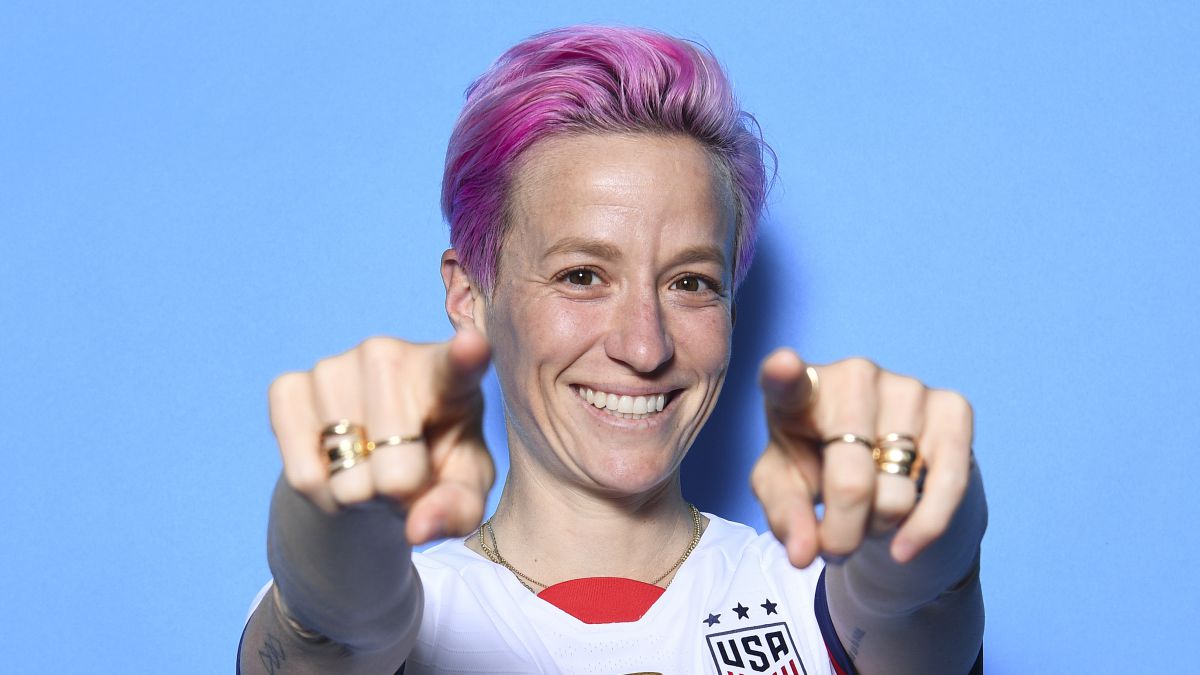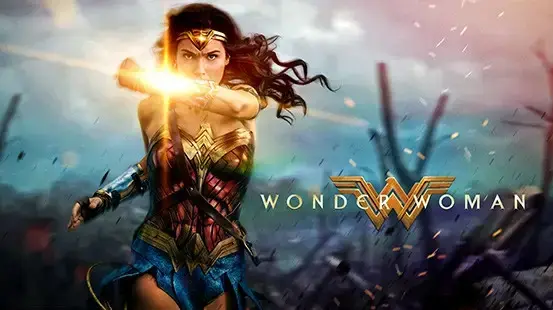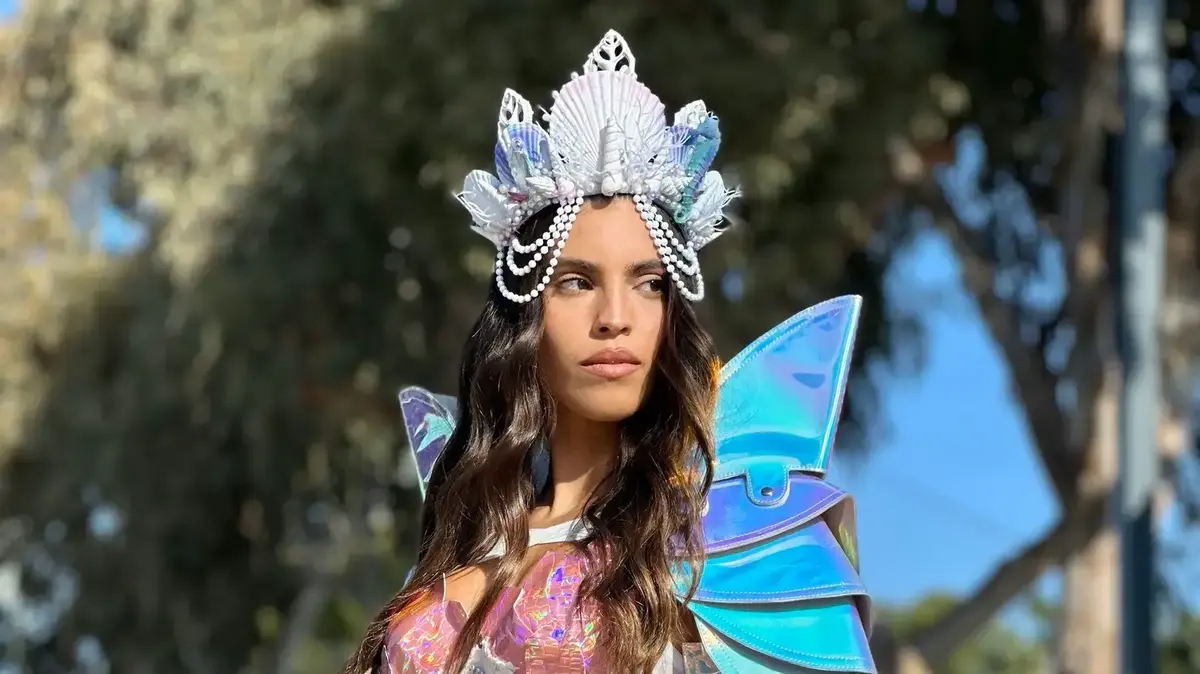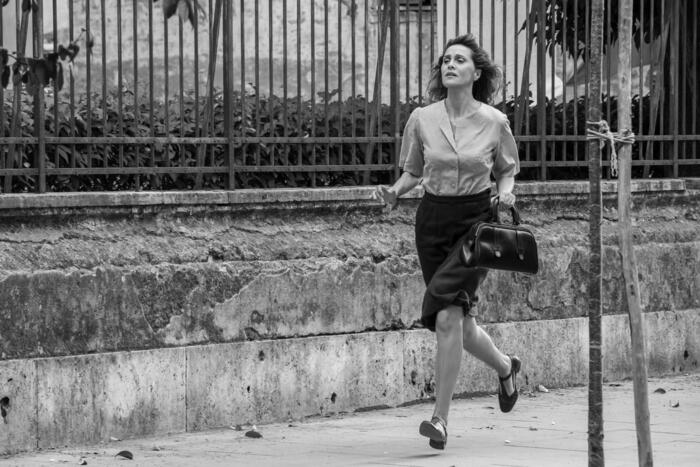Baron Pierre de Coubertain, founder of the Olympic movement, said at the beginning of the 20th century that the place of women was not in sport, because it was "unsightly, inappropriate and unacceptable".
An exercise in misogyny that should also be contextualized in his time.
If he raised his head today and found out that
at the Tokyo Games gender parity will now be almost absolute
, he would quickly return to his grave.
Women, as in all areas, have also had to open a gap in sport.
In some such as football or cycling it has cost them a lot.
But some were not left alone there.
Aware of the transformative power of sport,
some women have used it as a platform to fight
against machismo, racism, phobia against gays and lesbians, wage inequality or prejudice against emigration ... From Alfonsina Strada, the woman who se dared to run a Giro against men in 1924, until the Syrian swimmer and refugee Yusra Mardini, this is a journey through the history of the sports revolutionaries.
Kathrine Switzer
She was the first woman to run a marathon with a bib, in 1967 in Boston.
They tried to expel her, and that image made her an icon of feminism.
Jose Andres Ezquerro
Kathrine Virginia Switzer, born in Amberg (Germany) on January 5, 1947, became in 1967 the first woman to run a marathon, the Boston one, with a race number.
She wore the 261 and left an image for history when one of the judges, Jock Temple, who served as co-director, tried to push her out: "Get out of my career, give me back my number!"
That action earned her to become an icon of feminism and a symbol in the fight for equality.
That photographic sequence was chosen by 'Time' magazine as one of the 100 photos that changed the world.
Switzer's boyfriend, Tom Miller, and several other runners stopped Temple and escorted the athlete to the finish: he set a time of 4:20.
“I registered as KV Switzer and they thought I was a man.
But I did not do it to deceive: I wanted to be a writer and admired authors like JD Salinger ”.
Despite the poor reception in the media, his participation received the support of North American society.
In 1974 she won the New York women's marathon and finished second in 1975. She then achieved her best time with a time of 2:51:37.
For 20 years she promoted the Avon Circuit, which consisted of 400 competitions in 27 different countries for more than a million women.
His project was an acceleration for the IOC to accept the women's marathon as a sport within its program.
He currently runs '261 Fearless', a non-profit organization that promotes the creation of running clubs for women.
The number 261 is retired in Boston in his tribute.
Alfonsina Strada
"The devil in a skirt" is the only woman to compete in the Lombardy and Italian Tours alongside men.
He fought for gender equality in cycling.
Jose Andres Ezquerro
Alfonsina Strada fought against segregation in cycling through her skill with the bicycle, used as a tool and symbol of the fight for gender equality in her time.
Born on March 16, 1891 in Castelfranco Emilia as Alfonsa Rosa María Marini, nicknamed Alfonsina, she changed her surname from Marini to Strada when she married.
Luigi, her first husband (twice widowed), helped her become a professional runner thanks to the bike he gave her as a wedding gift.
He was also her personal trainer.
But his passion began long before, when his father presented him with a rudimentary machine at the age of ten.
The hobby became a way of life and a loudspeaker to confront machismo and demand the same rights.
He went on to win 36 races against men and competed in two Giros d'Italia for men and one Giro d'Italia for men.
They called him The Devil in a Skirt.
In 1911 she set the record for the female hour.
As the regulations of that time did not contemplate the participation of women, the Lombardy organization could not oppose Alfonsina's enrollment in 1917 (the 32nd finished).
He repeated in 1918 (21st).
His greatest milestone was reached in 1924. Although it is not clear if he slipped under the name Alfonsín Strada or if it was a mistake, the fact is that he competed in the Corsa Rosa, one of the three big ones, with number 72. During the seventh stage suffered a fall and his bicycle broke.
She went out of control and was excluded from the general classification, but due to the raised expectations they allowed her to complete the Giro (28 hours behind the winner, Giuseppe Enrici, and ahead of two rivals).
In 1925, those responsible vetoed the women's competition in the Giro d'Italia.
She continued on her way to change the bike for the motorcycles.
He died in 1959, at the age of 68, when his heart stopped, hit by his motorcycle.
Martina Navratilova
The Czech escaped communism to seek asylum in the United States and make her homosexuality public.
He called Trump "sexist and racist."
Jesus Mínguez
Martina Navratilova is the record tennis player.
This is evidenced by his 167 individual titles (with 18 Grand Slams, including nine at Wimbledon), 117 doubles (31 in majors), 331 weeks as number one ... A force of nature that was born in 1956 in a wrong place, Prague, in the former communist Czechoslovakia.
An atmosphere that drowned him.
That is why in 1975, at just 18 years old, he decided to leave his country and request political asylum in the United States.
When he obtained his new nationality in 1981 he felt free.
He gave an interview to the 'New York Daily News' and made public his bisexuality.
Something taboo in sport.
Since then, it has become a reference for the gay community.
He did not fear the consequences (which he had) because he continued playing until 1994 and even returned between 2002 and 2006.
"My life has always been based on justice, so if I see something unfair, I denounce it," he declared in 'The Sunday Times'.
That is why he encouraged athletes to speak openly about their sexuality.
That is why he asked for the withdrawal of the name of Margaret Court (the woman with the most Grand Slams in history with 24) after the Australian's criticism of the LGTB collective.
That is why, too, she denounced the wage inequality when she learned that John McEnroe charged ten times more than her for commenting on matches.
He even defined Donald Trump as a "threat to the world" and called him "sexist and racist."
To normalize homosexual relations, he did not hesitate to propose to Julia Lemigova, a former model and Russian businesswoman, during a break from the US Open 2014 before the cameras.
Always in front.
Ellen MacArthur
The British sailor went from touring the world by boat accumulating numerous records and accolades to promoting a more sustainable lifestyle.
Jorge Noguera
Ellen MacArthur's life is one based on circulation.
His own and that of the products we consume.
MacArthur was born 44 years ago in Whatstandwell, a tiny town in Derbyshire, England.
Paradoxically, since they measured more than 100 kilometers between this town and the nearest coastal point, she would become one of the most celebrated British sailors of all time.
At 17 he bought his first ship, a Corribee which he named 'Iduna', and aboard it he sailed around Great Britain.
When he retired from the competition in 2009, 15 years later, he accumulated a series of records and recognitions equal to very few.
She was the fastest woman to make a solo transatlantic crossing between the United Kingdom and the United States, with the 'B & Q / Castorama' trimaran (7 days, 3 hours and 50 minutes in 2004), and the fastest person to go around the world alone and nonstop (71 days, 14 hours and 18 minutes in 2005) with the same boat, a record that Francis Joyon would snatch from him in 2007.
These sorts of feats earned her the titles of Dame Commander of the Order of the British Empire and Honorary Lieutenant Commander of the Royal Navy Reserve.
After his retirement he created the 'Ellen MacArthur Foundation'.
With it, it promotes the circular economy and a more sustainable society that manufactures more durable products, consumes less and uses renewable energy.
Everything to preserve nature, which for so many years was his home.
Megan rapinoe
The American soccer player is not only one of the best players of the last decade, but an activist against inequalities.
Juanma Leyva
Megan Rapinoe (Redding, California, 1985) is one of the best known faces in American sports.
The talented soccer player, golden ball in 2019, is one of the stars of the current world champion US team, capable of stopping the country and bringing together more than 14 million spectators during the World Cup final.
Her image has monopolized covers and advertising campaigns, although its importance goes far beyond sports, since as she has recognized, the popularity she has gained on the field has provided her with a platform with which to launch social messages.
Married to the four-time Olympic basketball champion Sue Bird, Rapinoe never hid her sexual orientation, which she carried as a flag, becoming an icon in the fight for equality for the LGBT community, in which she has been involved in numerous campaigns.
However, his activism does not end there.
She was one of the promoters of the complaint of the North American women's team to their federation to claim salary equity with the men's team.
And he did not hesitate to show solidarity with quarterback Colin Kaepernik by reproducing his kneeling gesture during the American anthem to denounce racial violence.
In recent years, her clashes with President Donald Trump and her refusal to visit the White House to celebrate the World Cup made her a spokesperson for a part of American society.
Such is its impact that surveys have been carried out on its acceptance if it wanted to start a political career.
Annika Sorenstam
The Swedish golfer achieved 10 'majors' and a total of 94 professional victories.
But his great achievement is his foundation, dedicated to helping young people around the world in golf.
Jorge Noguera
No player in the history of European golf has won as much as Annika Sörenstam.
A total of 94 victories in the professional field mark the career of this Swede born 50 years ago in Bro, near Stockholm.
They are figures from another world, second only to American players from times when golf was not such an open and volatile sport.
Of that very extensive string of triumphs, a whopping 10 got them in the 'majors'.
Once again, no one in the modernity of this discipline has achieved a better record than his.
She was considered the best player on the LPGA, the North American women's circuit, eight times.
And in eight others, he topped the earnings list, amassing more than $ 20 million in his entire career.
Since 2003 he has been a member of the Golf Hall of Fame
In 2008 he ended 16 years of professional competition.
Since then she has captained the European Solheim team (as a player she was an institution in the tournament with 24 points from 37 games and two titles), has commented on tournaments on television and has embarked on multiple businesses, from field design and a academy to a clothing brand or wine production.
Since 2007, she has carried out philanthropic work with the ANNIKA Foundation, which helps players of all levels to forge a career in golf, from the institute to the professional world.
Everything she got she wants for others.
This is Annika Sörenstam, a voracious champion and a model person.
Billie jean king
The American won 12 Grand Slam, beat former male number one Bobby Riggs and created the WTA (Women Tennis Association).
Dani miranda
Women's tennis has in the American Billie Jean King one of the historical figures, both at a sporting level, since she conquered 12 individual Grand Slam, and at the level of fighting for the rights of all her teammates.
She vindicated feminism throughout her career and at the age of 29, in 1973, she played a match against world number one Bobby Riggs, 45 at the time and who had previously criticized the women's game.
It was called the 'Battle of the sexes', and the victory went to King (6-4, 6-3 and 6-3), a triumph that gave much more strength and recognition to their fight: "Women can compete with skill before men. ”The meeting was watched live by 90 million people around the world.
That same year, she was a fundamental part in the creation of the WTA, the governing body of the women's professional circuit and which is still in force.
The US Open distributed the same prizes to men and women for the first time after an initiative by Billie Jean King, as she threatened not to participate, a proposal that was followed by more players.
She retired in 1982 with 37 Grand Slam titles (12 singles, 16 in women's doubles, and 11 in mixed doubles).
More than half (20) were at Wimbledon.
She was named by Life as one of the 100 most important Americans of the 20th century and leads various organizations for equality.
Endless claims of Billie Jean since the age of 12, when in 1955 Billie Jean was excluded from a group photo of youth tennis players because she had decided to wear shorts, instead of a skirt.
Maya moore
One of the best basketball players in history stopped her career at just 29 years old to fight the injustices of the American legal system.
Juanma Rubio
Maya Moore had it all, she had earned it hard, and at the age of 29, in theory, the best years of her career awaited her.
Just when, in addition, the WNBA began to take off and to put at least one foot on the great American media scene.
Voted the biggest winner in the history of women's basketball by Sports Illustrated in 2017, she had been No. 1 in the draft in 2011 after sweeping (two titles) with UConn University.
With Minnesota he had won four rings, he had been MVP of the season and of the final, six times all star, Top Scorer, Rookie of the Year ... Everything: and four golds with Team USA in the 2010-16 cycle, two in World Cups and two Olympians.
But in 2019, with the WNBA at his feet, he stopped.
His reasons were working for his faith and his community and, ultimately, fighting the injustices of the American justice system.
He focused on freeing Jonathan Irons, who had been serving a sentence since the age of 16 in a jail in Jefferson City, the place where Moore was born, in the hard part of Missouri.
Irons was released last year at 40, after turning nearly 22 for an assault and robbery case in which his guilt was never really proven.
Today, free, he is also Moore's husband, who continues with a task that made him put aside his beloved basketball: “Your legacy will not be written if you are not fully committed to what you have to do.
Legacies are built with total dedication, an absolute commitment to your people ”.
Hassiba Boulmerka
The Algerian athlete, Olympic champion in Barcelona 1992 in shorts and a world cup of 1,500, became a symbol of the liberation of women.
Juanma Leiva
Hassiba Boulmerka (July 10, 1968, Constantine, Algeria) is one of the most important athletes in history and a symbol of African sport.
Her gold at the World Athletics Championships in Tokyo in 1991 was the first for an athlete from that continent and her triumph at the Barcelona 92 Games, the first in Algeria's history.
But her achievements were not enough for her country's fundamentalists to despise her and even threaten her with death.
The reason: she was competing without a hijab at a time when no Muslim woman did.
With her head uncovered and wearing shorts, which placed her in the crosshairs of religious radicals, who accused her of not being Muslim.
That forced her to leave her land and train in Europe, but it also made her an icon of women's liberation.
It meant a revolution for Muslim athletes, although that also meant that she had to be protected wherever she competed for fear of attacks.
All that led him to receive the then Prince of Asturias Award in 1995.
For his enormous sporting results (that year he won his second world gold in 1,500) and, above all, for opening the way to other athletes.
A task that continued when he left the sport.
It is linked to the International Olympic Committee, a body in which commissions for Sport and Women for Africa and Arab athletes have participated.
A symbol of equality and the liberation of women, an athlete whose example crossed the boundaries of sport.
Yusra Mardini
The swimmer left her country in 2015 in a boat that she had to propel by swimming to avoid a shipwreck.
She participated in Rio 2016 as a refugee.
Dani miranda
Swimmer Yusra Mardini left Damascus (Syria) in 2015, when her home, city and country were ravaged by war.
First they set sail for Lebanon, then Turkey and later the plan was to reach Greece in a small boat ... which broke down during the journey.
About twenty people were on board (it was built for seven) and they ran out of engine in the middle of the Aegean Sea.
Mardini swam for three hours and, with the help of other 'passengers', managed to push the boat to the island of Lesbos, on Greek soil.
"All the way, only prayers were heard," he said later after a successful odyssey.
Mardini moved to Germany shortly thereafter after taking buses, on foot ... until he reached Berlin to continue with his profession and his passion: swimming.
For the Rio 2016 Games, the IOC formed the first Olympic Refugee Team, with Mardini being one of the ten selected (six men and four women) to be in Brazil competing under the Olympic flag.
"Sport was our way out. It gave us hope to build new lives," the 22-year-old athlete recently said.
He participated in the 100 free and the 100 butterfly and, after the appointment, he made his story known worldwide.
Since then, she has helped others who had and have to flee, like her, teaching swimming lessons for refugee children.
She is also an ambassador for UNHCR (UN Refugee Agency).
In Tokyo there will also be, for the second time, a Refugee team with Mardini at the helm.
Nawal El Moutawakel
Moroccan Nawal El Moutawakel won the 400 hurdles in Los Angeles 1984. The first gold for an African and Arab woman.
Keep fighting from the IOC.
Jesus Mínguez
On August 8, 1984, in Los Angeles, Nawal El Moutawakel (Casablanca, 54 years old) entered the history of Olympism.
She won the 400 hurdles, wearing shorts and bareheaded, and became the first African and Arab woman to be proclaimed Olympic champion.
Earlier, a very open-minded father had encouraged him to practice track and to say 'Yes' when a letter arrived at his home offering him a scholarship to study at Iowa State.
In the United States, she learned English and became a university champion.
After his retirement, he went to the offices.
In 1995 she was elected director of the World Athletics (international federation) and in 1998, a member of the International Olympic Committee.
His voice did not fade.
It sounds louder.
The Moutawakel hung up the spikes, but was clear that he had to harness his potential in pursuit of equality.
"The 400 fences are a mirror of life, they taught me to be stronger, to break the limits, throw down the barriers and walls. To find excellence," he said in an interview with AS.
In the Moroccan team in Los Angeles, she was the only woman.
"I realized that my mission was to become an ambassador who would give a voice to all of them in Morocco, in Africa and in the Arab world, where many do not have the opportunity to participate in sport," he says.
"Arab athletes are no longer invisible," sums up one of their voices within the IOC.
Powerful in offices, just like on billboards.
Alice coachman
The American was the first black Olympic champion.
He did it in the high jump in London 1948. He made sport a battering ram against racism.
Jesus Mínguez
United States, 1948. A year in which 60% of black families lived below the poverty line.
A time when racism was rampant.
A time when many states adopted Jim Crow laws that established racial segregation.
There were still a few years left for the civil rights movements to explode.
So that Martin Luther King could stir consciences.
Blacks, yes, counted for sport.
To win medals.
Like the one Alice Coachman achieved in the London 1948 Games, one of 38 women among the 300 athletes of the Stars and Stripes.
Coachman (Albany, 1923-2014) broke the bar at 1.68 meters (she was still jumping with the ventral roller technique later retired by Dick Fosbury) and became the first black female Olympic champion.
A leap also over racial barriers.
In London, King George VI of England hung the gold around her neck, and on her return to the United States she was received along with the rest of the expedition by President Harry Truman.
But in Albany, in racist Georgia, the reception was in a segregated black and white auditorium and the mayor did not deign to shake his hand.
He left there through a side door.
But Coachman's jumps and successes continued to help remove prejudices.
In 1952, she became the first African American to promote Coca-Cola.
As a child (fifth of ten siblings) she could not even access public courts due to the color of her skin.
But he fought and won.
Coachman made sport a battering ram against racism.









